Ganache recipe for coating a white cake. How to Cover a Cake with Ganache and Get Perfectly Sharp Edges
Many fans prefer the method of spreading it over a layer of ganache cream. Ganache for leveling a cake under mastic allows you not only to get another hint of flavor in the finished delicacy, but also to facilitate the process of applying mastic and its leveling. Read below about some techniques for preparing ganache for mastic.
Chocolate ganache for mastic - recipe
Ganache is always prepared on the basis of chocolate, and any kind of chocolate: black, white, milk, all the same, the preparation technology and proportions will remain the same. For cooking, you cannot use porous chocolate, and especially not one that contains various additives. Also note that the taste and quality of the chocolate will affect the taste finished cake, so give preference to proven products.
The basic recipe is simple and is based on a 5:1 ratio, that is, five parts chocolate to one part cream, so per kilogram of chocolate you will need 200 grams of cream. Crush the chocolate into pieces of equal size, then pour cream over them and place everything in a bowl. After 30 seconds, stir the contents and return it to the microwave for a similar period of time. Repeat the procedure until everything chocolate pieces will not disperse completely. Next, cover the ganache tightly with film so that the surface does not weather, and refrigerate. After 6 hours, the ganache can be used, but first it will need to be left in the room temperature for an hour. When the ganache is slightly warm, spread it over the cake in two batches, re-cool the dessert for about another hour and begin spreading the mastic.
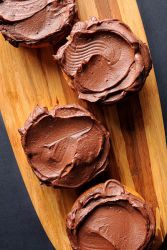
By analogy, white chocolate ganache with mastic is prepared.
The ganache will be noticeably more airy if you use sour cream rather than cream. This recipe can work if you use dark chocolate.
How to cover a cake with ganache and get perfectly sharp edges? Oh ganache! You make the cakes look great and the edges of those cakes are sharp! But you are the reason for spatulas thrown in anger and evil curses addressed to you. In this article you will find a description of a method for coating a cake with ganache, which will definitely make you friends with this chocolate miracle! The fashion for cakes with smooth, sharp edges first appeared in Australia, and from there it spread throughout the world. There are many methods for covering a cake with ganache; this method is a synthesis of several. In general there are no right or wrong correct methods, the most important thing is to find a method for yourself! The key to success lies in the correct consistency of the ganache. Moreover, the concept “ correct consistency” is purely subjective. Some pastry chefs like to work with dense ganache, others, on the contrary, with softer ones. Choose a consistency that is convenient for you; it is possible to use a denser ganache in the layer of the cake, and a softer one for the coating. If you've never made ganache before, here you go. short description how to make ganache. There is no recipe as such, there are only two key ingredients - chocolate and cream, and their proportions. To get a high-quality ganache, try to use the most best chocolate, which you can only afford. Only in this case will you be able to experience the taste and texture of real, high-quality chocolate. For dark ganache (50-60% cocoa content) you will need 2 parts dark chocolate and one part cream of at least 33%. If the temperature environment quite high, you need to take 2.5 or even 3 parts of chocolate. For milk ganache(30% cocoa content) you will need 3 parts milk chocolate and one part cream not less than 33%. In warm weather, the amount of chocolate should be increased to 3.5-4 parts. For white ganache you need to take 3 parts white chocolate and one part cream, at least 33%. In warm weather, as with milk ganache, increase the amount of chocolate to 3.5-4 parts. In general, white chocolate is the softest chocolate; white chocolate ganache tends to spread in the heat, so many confectioners are not very willing to work with it in the warm season. If you're a beginner, it's best to start with a dark or milky ganache. Ingredients: Dark chocolate ganache 2 parts chocolate: one part cream at least 33% Milk chocolate ganache 3 parts chocolate: one part cream at least 33% White chocolate ganache 3 parts chocolate: one part cream at least 33% Instructions: Very Finely chop the chocolate with a knife. Pour the cream into a deep saucepan with thick walls, place over medium heat, keep on heat until small bubbles appear on the surface, remove from heat. Cool slightly until the bubbles disappear and add the chocolate, tilt the pan from side to side so that the cream covers the chocolate and leave for a few minutes to melt the chocolate. Then gently stir the mixture until smooth using a silicone spatula; you can use a whisk, but it must be completely dry! Place the pan over a VERY low heat and stir until all the chocolate pieces are completely broken up and the mixture is glossy and smooth. Pour the ganache into a microwave-safe bowl, cover with cling film and leave overnight at room temperature to stabilize. In general, you can store the ganache at room temperature for a couple of days, or you can refrigerate it and store it for a month, or even freeze it for a little more long term. These times are approximate and may vary depending on ingredients used and storage temperature. more content cocoa in ganache, the better it is stored. What to do if your ganache is not smooth, but grainy. This happens if the chocolate and cream are not emulsified. Don't panic, the ganache can be saved. The first thing to try is to use an immersion blender, simply place it in the ganache and blend for 30 seconds, once the ganache is smooth, turn off the blender immediately, otherwise the ganache will become saturated with air and become porous. If that doesn't work, there are a couple more things you can try. The first is to add a little cream and mix, this will make the ganache smooth. But keep in mind that the ganache will not be as dense. You can also try placing the ganache in the refrigerator, stirring every 10 minutes. Once the ganache is ready and it has sat at room temperature overnight, it's time for the fun part - coating the cake with ganache! If you're doing this for the first time and you're afraid you'll never be able to get super sharp edges, don't worry, this article will help you! And most importantly, more practice! So, let's go! What we need: Cake; 2 round cake mats the same diameter as the cake; Scraper with 90° angles; Parchment paper; Pencil and scissors; Bread knife (knife-saw); Cutting board; Rotary table; Putty knife; Clean building level; Non-slip mat. Cut from baking paper circle according to the diameter of the cake, take one of the round mats, add a couple of drops of ganache, place a circle of parchment on top, press and place in the refrigerator for the ganache to harden. This is necessary so that the paper does not “run away” from the substrate. Using a ruler and a bread knife, cut your cake into equal height layers. To make the cake easier to cut and not crumble, after baking, cool it and wrap it in cling film and leave it overnight in a cool place or refrigerator, the moisture will be evenly distributed inside the cake, and the cake will be much tastier, and it can also be easily cut. Cut a circle out of paper, half a centimeter in diameter smaller than the cake base, and trim the edges of each cake along this circle. Gently heat the ganache in the microwave until it reaches the consistency peanut butter. Place a piece of non-slip mat on the turntable, place a second mat on top of it, add a drop of ganache onto it, and place the first cake layer on top. Coat it with ganache or cream, depending on the type of cake you are preparing. Next, repeat this operation with all the cakes, try to stack the cakes on top of each other as evenly as possible. Place a drop of ganache on the topmost cake layer and place a layer of parchment paper, which we previously placed in the refrigerator. Gently press the cake. Use a scraper to ensure that the top and bottom backings match, they should be flush against each other. Shake off the crumbs and put this entire structure in the refrigerator so that the ganache hardens and the bases do not move out. Reheat the ganache if necessary and spread the ganache onto the sides. Hold the top pad with one hand and apply ganache towards it, and so on throughout the circle. Do not touch the cake with the spatula to avoid picking up crumbs. In general, to avoid picking up crumbs, you can cover the cake with a very thin layer of ganache and let it set in the refrigerator, and then start covering the cake with the bulk of the ganache. Add more ganache; it should extend in a thin layer beyond the top board. Place a bench scraper against the cake so that the bench scraper rests on the top and bottom cake pans. and begin to rotate the table, let your hand remain motionless. If a hole has formed from an air bubble, cover it with ganache and scrape again, continue until you get smooth, even sides. Next, place the cake in the refrigerator to allow the ganache to harden. Insert a spatula between the top liner and the parchment paper and draw a circle with it to release the parchment from the backing paper. Carefully remove the parchment. Heat the ganache again, but this time it should be a little softer, the consistency of butter that was left in a warm room. Apply a thick layer (about 1 cm) to the top of the cake and smooth it out. It will go a little outside the cake, no big deal. Place a piece of parchment on top of the cake, smooth it out, trying to remove as many air bubbles as possible. Place on top cutting board and turn the cake over. Place a spirit level on the cake and level it, applying gentle pressure where necessary. Run a scraper under warm water, wipe it dry, and scrape down the sides of the cake again, removing any excess. Make sure there is a right angle between the sides of your cake and the base! Refrigerate the cake again. Turn the cake over again and carefully remove the parchment board. If there are any cavities on the surface of the cake, fill them a small amount ganache, reheat the scraper, wipe it dry, and scrape the sides and top of the cake again, making sure the ganache on the cake is cool and firm. That's all. Leave the cake overnight at room temperature, then you can cover it with mastic or leave it as you like. A cake covered with ganache does not need to be stored in the refrigerator, unless of course you used it for filling. perishable food, For example fresh fruits. And remember, if you decide to cover such a cake with fondant, it should be at room temperature so that the fondant does not float and you do not become sad. Wishing you perfect edges and sharp corners in this difficult task of covering the cake with ganache!
Often, when creating real confectionery masterpieces, mastic is used, from which confectioners can make a wide variety of figures and decorations for cakes. Chocolate mastic is very simple to prepare; every housewife can make it independently at home using gas stove or microwave, and with a minimum of effort.
Chocolate cake mastic can be prepared according to different recipes, the choice of which depends on the type of product used - white, milky or black.
White chocolate mastic recipe
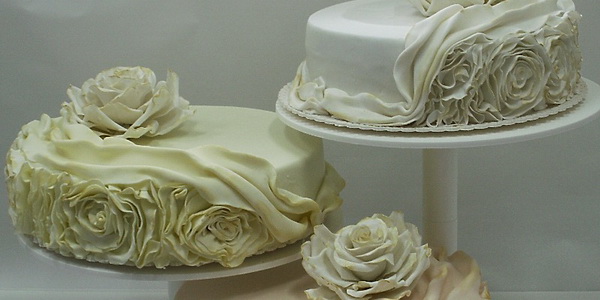
White chocolate mastic is needed by confectioners to create beautiful jewelry in the form of flowers or bows. Mastic white It’s also great for covering cakes, because light cake provides ample opportunity for the confectioner's imagination. For this white chocolate mastic recipe, you need to use the following products:
- 300 grams of white chocolate;
- 100 grams of powdered sugar;
- milk – 2 tbsp;
- butter;
- potato starch - the more the better.
Preparation:
1. Break the chocolate into pieces, place in a small container, add milk and the same amount of butter. Place this mass on water bath and melt until the mixture has a homogeneous consistency. It is important not to overheat the chocolate, otherwise it will simply curdle and you will no longer be able to make mastic from it.
2. Once the chocolate bar is melted, remove the container from the water bath and rub the mixture over the walls of the dish. If at this moment you see that there are small pieces of chocolate, put the container back in the water bath for a few minutes and grind the mass again.
3. Carefully pour the sifted chocolate mixture into the chocolate mixture. powdered sugar and mix well until the mixture becomes thick.
4. Place the mastic on the table, sprinkled with powdered sugar, and knead it until it has an elastic consistency.
If you are preparing fondant for flowers and other decorations, they should be made 2-3 days before preparing the cake.
How to make mastic from dark chocolate and honey
![]()
You can also make mastic from chocolate and honey at home. To prepare such a mass for covering or decoration, use dark chocolate. To make chocolate and honey mastic, use the following products:
- – 400 grams;
- condensed milk – 100 g;
- 100 grams of sour cream;
- butter– 100 g;
- tile ;
- 2 tbsp. l. liquid honey.
You can buy ready-made biscuits or make your own. Let's start preparing chocolate mastic according to this recipe:
1. Turn the biscuit into fine crumbs. To do this, you can first lightly dry it in the oven.
2. Beat softened butter with condensed milk and sour cream.
3. Combine this cream with biscuit crumbs, mix everything thoroughly until a homogeneous mass is formed. It should resemble a potato cake.
4. You can make any figures from the resulting mass that you need to decorate your dessert. Place the figures in the cold so that they harden well. In the meantime, you can start preparing the mastic.
5. Break the chocolate bar into small pieces: the smaller they are, the better. All chocolate should be divided into two parts - 1/3 and 2/3. Set a third of the broken chocolate aside, place 2/3 in a cup or small deep bowl and place in a water bath. Place the cup on the pan so that the bottom of the bowl with chocolate does not touch the water.
6. Place this structure on the fire and keep it until the chocolate begins to melt. All this time, the chocolate mass must be stirred continuously. You cannot keep chocolate on the fire for a long time, as it will curdle at temperatures above 37 degrees. Pour the rest of the chopped chocolate into the chocolate mass, well heated in a water bath, and mix well until completely dissolved.
7. Add heated honey to this mixture, stir until completely thickened, you won’t have to wait long - no more than 2-3 minutes. Now start kneading this mass with your hands until it has an elastic consistency. You need to knead the mastic for a long time - 15-20 minutes. During this work, a lot of cocoa butter will be released, which will flow down your hands, so you need to knead over a bowl.

From this chocolate mastic You can sculpt figures or roll it out and use it to cover cakes. When rolling out the viscous mass, you can use special coatings that will help you obtain an interesting texture. For example, the texture of “wood” is used by confectioners to create trees, stumps or animal fur - a boar or a bear. Transfer the rolled out layer of mastic to your figures, carefully cover it with this elastic mass and decorate the cake. To prepare the mixture for covering and decorating cakes, you can use not only chocolate bars, but also candies.
Mastic made from marshmallows and chocolate (white, milk or black)
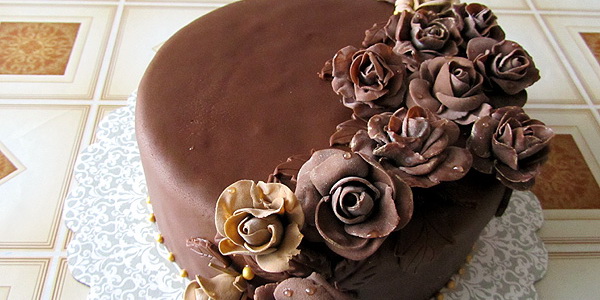
Marshmallow and chocolate mastic is also often used to create confectionery masterpieces. To prepare such a mixture for decorating baked goods, you will need the following products:
- marshmallow candies “Marshmallow” – 50 grams;
- white, milky or – 50 g;
- a tablespoon of butter;
- milk – 2 tbsp. l.;
- a pinch of citric acid;
- powdered sugar – 100 grams.
Mastic made from marshmallows and white chocolate or any other always turns out elastic, so it is easy to form any figures from it.
Prepare the mastic in the following way:
1. Break the chocolate bar into small pieces, place in a ceramic or glass container. Add marshmallows, milk and citric acid. Place the container with this mixture in a water bath and melt.
2. Do not bring the mixture to a boil. Remove it from the heat as soon as you notice that the chocolate has begun to melt. Add butter to the chocolate mass, gradually add powdered sugar, mix everything thoroughly to obtain a mixture of thick consistency.
3. Place the mastic on the table well sprinkled with powdered sugar. Knead it until the mastic acquires an elastic consistency.
If you need dark chocolate-colored mastic to decorate your baked goods, you can add a tablespoon of cocoa powder to give it more richness. The cocoa bean powder must be sifted to prevent lumps from forming. You need to add cocoa at the very beginning along with powdered sugar.
Chocolate cream ganache with mastic
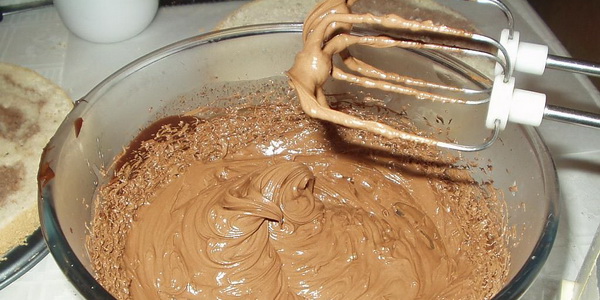
Ganache- This french cream based on chocolate, which is applied to the cake under the mastic, so it sticks better to the baked goods. In addition, ganache is applied under chocolate mastic to even out the surface. confectionery product, this cream is also used for decorating and covering cakes.
To make such a chocolate cream for mastic, you can use any type of this sweetness - milk, black or white. There are several recipes for making ganache. One of them must be used chocolate bar and cream. Chocolate and cream should be taken in the following proportions:
- 300 grams / 200 ml cream;
- 400 g milk chocolate / 200 ml cream;
- 200 g dark dark chocolate / 200 ml cream.

The chocolate must be finely chopped. Place the cream in a container, put on the fire, bring to a boil and remove from the stove. The cream must be stirred constantly so that it does not burn. As soon as the cream is removed from the heat, add chopped chocolate to it, stir everything with a silicone or wooden spatula until completely dissolved. The mass should acquire a homogeneous consistency.
After this, transfer the ganache into a small bowl, cover it on top cling film, pressing it tightly against the cream to remove air, otherwise a crust will form on the surface. Wrap the top of the bowl again with film and place in the refrigerator until the morning. In the morning, three hours before applying the ganache under the dark chocolate mastic, remove it from the refrigerator so that the cream warms up to room temperature and becomes more pliable in the hands of the confectioner.
Recipe for ganache with cream, butter and chocolate
There are other recipes for making ganache with mastic from white, black or milk chocolate. Besides the cream additional component butter can become the cream. Ganache from butter and chocolate under mastic is prepared from the following components:
- 110 ml cream – 33-35% fat;
- 100 g chocolate - black, milk or white;
- 35 g butter;
- powdered sugar – 2 tbsp. l.
Prepare cream ganache in this way:
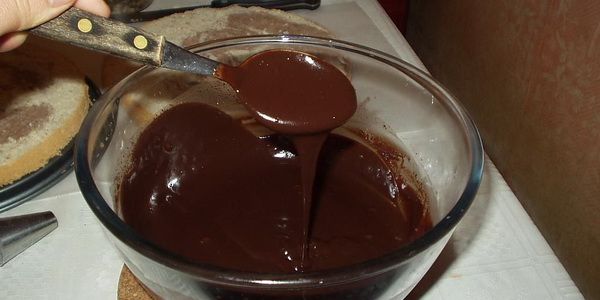
1. Break the chocolate and place it in a small container– ceramic, glass or metal.
2. Pour cream into a saucepan, add powdered sugar to them, mix everything thoroughly.
3. Bring the cream to a boil over low heat., stirring them constantly, but do not boil, remove from the stove.
4. Combine hot cream with chocolate, but do not mix these components, leave it like this for a few minutes. After a while, mix using a whisk, you should get a homogeneous mass of medium consistency.
5. Add a piece of butter to this mixture and mix again.
Such a ganache made from milk chocolate or any other type of fondant should turn out shiny and beautiful. However, after cooling, this French cream ganache loses its shine and becomes matte.
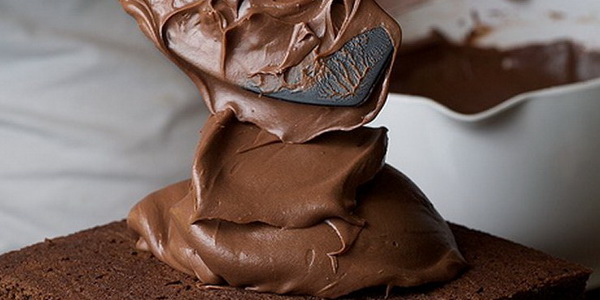
To apply cream under the mastic, you first need to level it with a hot knife and then leave it to harden. Before applying it to baked goods, it will have to be leveled again; to do this, the knife is moistened in hot water, and after contact with the cream, wipe with a napkin. When the cream becomes perfectly smooth, it is applied to the cake, left for 2-3 hours, and covered with mastic on top.
It should be remembered that mastic cannot be applied to wet surfaces (otherwise it will lose its shape or completely spread out). But if the cake is already soaked delicious cream(and this happens almost always), then what to do? It is necessary to create a “buffer layer” that does not allow moisture to pass through. Basically, for these purposes it is used either butter cream(also helps to level the cake) or ganache (a mixture of chocolate and butter that can be made with cream and is also used for leveling). We offer our readers a recipe for ganache cream for mastic.
In this master class we will show you how to prepare ganache for mastic. You should initially make a reservation that, depending on the chocolate you use, the ratio between chocolate and cream will change. For example, for 200 ml of cream there will be:
300 grams of milk chocolate (3:2)
400 grams white chocolate (2:1)
200 grams of dark chocolate (1:1)
We will cook with white chocolate and end up with a ganache like the one in the photo above.
Naturally, you can choose chocolate according to your taste needs (for example, make milk chocolate ganache), the process does not change.
Ingredients:
1. White chocolate 600 grams
2. Cream 300 grams
Preparation:
1. Chop the chocolate.

2. Place a saucepan with cream on the stove, bring the cream to a boil and remove from heat. Remember that cream is a dairy product and likes to “run away” from inattentive cooks. Stir the cream constantly so that it does not burn (otherwise the cream will have a very unpleasant taste and smell).
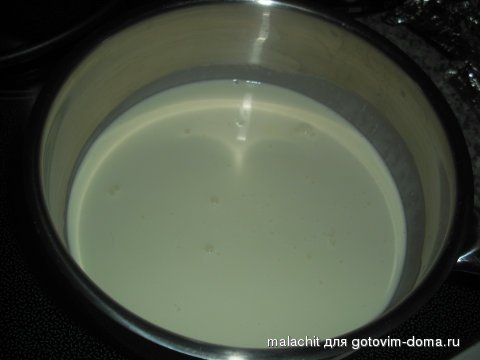
3. Now add the chocolate and stir thoroughly.
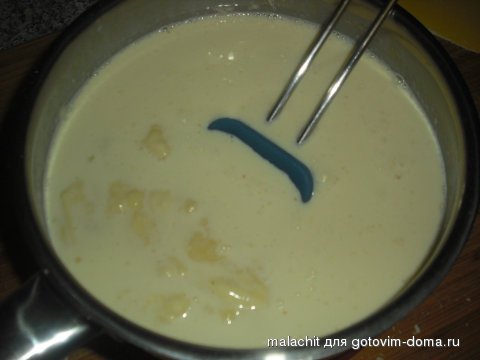
4. Soon the chocolate will soften and almost dissolve. Then we need a blender or mixer with an attachment like this:
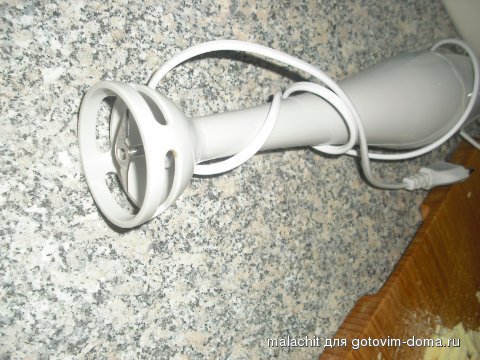
If you don’t have anything like this, you’ll have to knead long and hard by hand.
5. Immerse the mixer in the ganache and knead until the mass becomes homogeneous. It is important to remember that the mixer does not need to be moved either up or down, otherwise you will get foam instead of cream. It is enough to place the mixer on the bottom of the saucepan and stir until the bitter end, as in the photo:
Let's start with this:

And we’ll finish with a cream of this consistency.
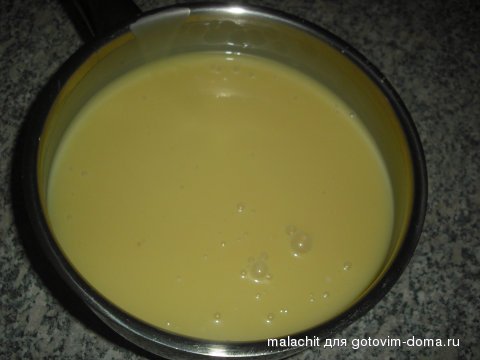
6. Now cover with film (so that there is no air between the ganache and the cream, otherwise a crust will form).
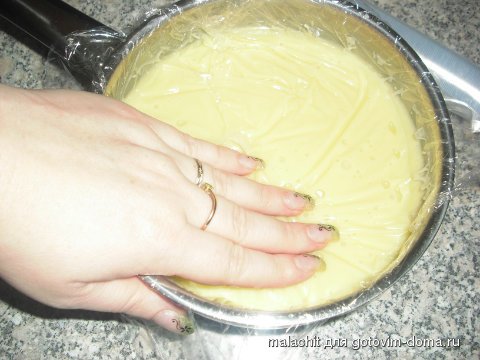
And we cover the resulting structure with another film, but on top, and put it in the refrigerator.
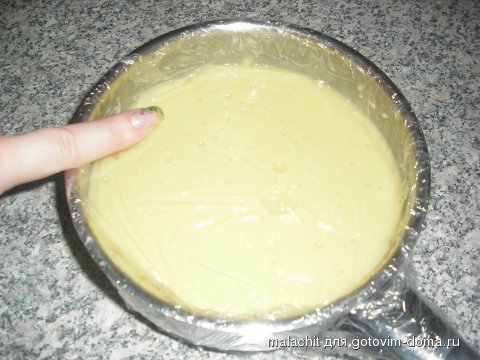
7. The ganache must cool completely, that’s when it will thicken. Before making the "buffer layer" between the ganache and fondant, let it sit at room temperature for at least three hours, otherwise it will be too hard.
This is what the finished mixture looks like:
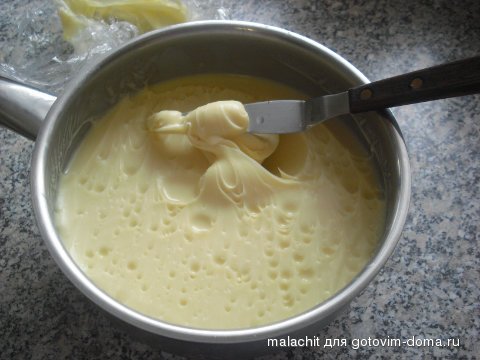
This concludes the master class on preparing wonderful chocolate cream ganache
Video on the topic of the article
These video lessons will help you if there are still unclear points.
Ganache is a thick, hardening chocolate cream. It is used as a finishing coating for cakes and pastries.
It can also be applied to the cake before applying mastic.
The chocolate mass perfectly levels the surface, hardens remarkably, and has a pleasant taste.
But for all this to really happen, the ganache needs to be prepared correctly. Here is a selection of the most popular recipes.
Chocolate ganache for coating the cake - general principles of preparation
The thicker the ganache, the thicker the coating layer will be and vice versa. If you need to make a thin glaze, apply the mixture while warm. If you want to get a thick coating, then cool the ganache and only then spread it over the surface.
General principles for choosing products:
Chocolate. Milk bars are not suitable for ganache; you need chocolate, and with high content cocoa. Preferably 65-70%. Only in this case will the product melt well, harden, and give the cream a good taste.
Sugar. Used for taste; any coarse or fine sand will do, but not powder.
Milk, condensed milk, cream, sour cream. They dilute the taste of chocolate, make the ganache softer, more pliable, and do not allow it to harden quickly. One of the products or two or more can be used, it all depends on the chosen recipe.
Oil. Added very often. We take natural products produced in accordance with GOST, that is, the fat content will be at least 72%. Otherwise, the ganache will not turn out as desired and may not harden.
Cocoa. It is advisable to choose natural black powder without sugar or other additives in the composition. Cocoa can be added to chocolate or used on its own, but the taste in this case will not be as deep and rich.
Of course, these are not all the ingredients used. There are recipes with honey, milk powder and cream, with various other additives. The technology for preparing the cream may also change slightly.
Chocolate ganache for cake coating: recipe with condensed milk
One of the simplest recipes chocolate ganache for covering the cake. This amount is enough for a product with a diameter of 23 cm. But, a lot depends on the thickness of the layer, temperature and density of the mass.
Ingredients
0.18 kg butter;
1 spoon of cocoa;
0.24 kg chocolate;
0.1 l condensed milk.
Preparation
1. Chop the chocolate, if it is not small, throw it into a bowl and put it on steam bath. Melt until liquid.
2. Cut the butter small pieces, put it in another bowl. Soften it. It is advisable to do this in advance.
3. Beat the butter with a mixer for five minutes and add condensed milk in parts. Bring the mass until smooth.
4. Add a spoonful of cocoa powder to make the cream deeper and more beautiful.
5. Remove the chocolate from the steam bath. Cool slightly, but do not let it harden.
6. Add chocolate to cream and beat. If the mass turns out to be liquid, then leave it for 5-10 minutes so that the ganache becomes thicker, but do not keep it for a long time and do not put it in the refrigerator.
7. Use the ganache to cover the cake immediately while it is soft and pliable.
Chocolate ganache for cake coating: recipe with whole milk
To prepare this ganache, use a simple whole milk, it is better to take with a fat content of at least 3%.
Ingredients
0.2 kg butter;
0.2 kg chocolate;
0.1 l of milk.
Preparation
1. Place a saucepan on the stove for a steam bath, while the water heats up, crumble the chocolate. Can be chopped with a knife.
2. Pour the chocolate into a bowl or a smaller saucepan and set to melt.
3. Heat the milk and add to the chocolate.
4. Continue heating on steam bath until all the ingredients of the chocolate cream have melted and the mass becomes homogeneous.
5. Remove from heat and cool slightly.
6. Add a spoonful of chocolate mixture to the softened butter and stir. Then pour in another spoon and so on until both creams turn into a homogeneous mass.
7. To taste, add a little vanilla or pour cognac. Stir. Let the ganache cool a little and it’s ready to use!
Chocolate ganache for cake coating: recipe with honey
Honey ganache coating recipe chocolate cake. The cream turns out incredibly aromatic and very tasty. There is no need to add sugar to the mass, since it is also in the tile. It is important to use in this recipe heavy cream With mass fraction above 30%.
Ingredients
60 ml cream;
40 g butter;
50 g honey;
110 g dark chocolate.
Preparation
1. Combine cream and honey and heat in a water bath.
2. While the mixture is heating, you can chop the chocolate into small pieces. We transfer it to honey and cream. Continue melting the cream until the mixture becomes homogeneous.
3. Remove from heat, cool until warm.
4. Add softened butter. Since only a small amount is added, there is no need to beat it separately.
5. Stir. Once the cream is smooth, you can coat the cake!
Chocolate ganache for cake coating: recipe with cocoa powder
An economical version of chocolate ganache cream for covering the cake. Important! So that the cream turns out tasty and in no way inferior to the coating made of full chocolate, you need to use high quality cocoa powder. You can add more sugar to taste, but no more than 2 tablespoons, otherwise the consistency may suffer.
Ingredients
100 g butter;
5 spoons of cocoa;
4 spoons of sugar;
160 ml milk.
Preparation
1. Take the butter out in advance to a warm room, you can cut it into cubes so that it softens faster.
2. First combine cocoa and sugar and stir. The grains of powder will rub against the sand, there will be no lumps.
3. Now dilute the sugar mixture with milk, stir and place in a water bath. But you can prepare such a cream in a regular saucepan with non-stick coating. In this case, turn on low heat and cook, stirring constantly so that the cocoa does not burn.
4. As soon as the sugar dissolves, the cream becomes homogeneous, you can remove it from the stove.
5. Cool the chocolate mass a little and add softened butter. Stir quickly until smooth. It's okay if the butter melts. As the cream cools, it will thicken anyway.
6. We use ganache to cover the cake or decorate cakes, ice cream, and homemade sweets.
Chocolate ganache for cake coating: recipe with cream and chocolate
Another very simple ganache recipe, but it is important to use at least 30% heavy cream. Both chocolate and cocoa powder are used here.
Ingredients
200 g cream;
170 g dark chocolate;
4 spoons of sugar;
1.5 spoons of cocoa;
1.5 tsp. cognac;
50 g butter.
Preparation
1. Heat the cream until hot, but do not boil. Up to about 70-80 degrees.
2. Add granulated sugar, combined with cocoa powder. If you pour them separately, lumps may appear. Quickly stir the cream. Leave for a few seconds and remove from heat.
3. Crumble the chocolate. You can chop it quickly with a knife. Transfer to a bowl.
4. Fill the chocolate pieces with hot cream and cocoa. Cover the bowl for a couple of minutes until the pieces melt.
5. Open, stir.
6. Add softened butter. But, if the cream is of high quality, then you can do without it.
7. Pour cognac for flavor. This amount is enough for the cream to give off a slight walnut, but at the same time there was no alcohol in it.
Chocolate ganache for cake coating: recipe with milk powder
A recipe for chocolate ganache for covering a cake, which can be prepared not only with milk powder, but also with cream. It will turn out even tastier, since the fat content of the product will be higher.
Ingredients
50 g milk powder;
60 ml fresh milk;
110 g butter;
150 g chocolate;
1 spoon of sugar.
Preparation
1. Chop the chocolate and place in a water bath.
2. Add sugar to the milk powder, dilute it all fresh milk or ordinary water, place separately on the stove and heat to 50 degrees.
3. Beat the butter with a mixer, gradually add milk to it. We do this slowly so that the oil absorbs all the liquid.
4. Remove the melted chocolate from the water bath and mix well. It shouldn't be hot. If necessary, cool a little.
5. Enter chocolate mixture into the butter, continuously whisking the cream.
6. Ganache is ready! To taste, add vanillin or cognac to it, as we did in previous recipe. Use the cream immediately before it hardens.
Chocolate ganache for cake coating: recipe with orange zest
In fact, you can make cream with lemon zest, but the taste and aroma will be completely different. We choose citrus at our discretion. Don’t forget to wash it thoroughly with a brush and pour boiling water over it.
Ingredients
200 g dark chocolate;
1 tbsp. l. orange zest or 1 tsp. lemon zest;
150 ml milk;
1 pinch of salt;
1 spoon of oil.
Preparation
1. Build a water bath. Place all the chocolate in the top bowl, after chopping it into small pieces. We begin to melt.
2. The zest needs to be chopped and added directly to the chocolate.
3. Heat the milk with a pinch of salt. If you want to get more custard, then add two or three tablespoons of sugar, but no more.
4. As soon as the chocolate and zest warm up and become homogeneous, add butter and stir.
5. Next, pour in the milk in a thin stream, take your time.
6. Warm the ganache for another minute in a water bath and remove.
7. Cool until warm, but not cold. We use it to decorate the surface of the cake or for any other purpose.
Does the ganache harden quickly and you can’t cover the cake? Place the bowl in a pan of warm water, let the mixture heat up and stir constantly. Scoop the glaze straight from it and cover the cake.
White chocolate is much more capricious than dark chocolate. It may not melt at all if the product is of poor quality or even a drop of water gets in.
